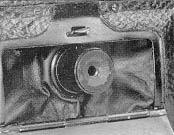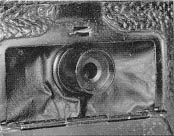By Harry Green
At the age of 12 a friend of our family came over to show us his new camera; it was a Kodak Panoram #1. He took a picture looking out our living room window and the lens swung around. By this time, I was a second-generation photographer and had converted my bedroom closet into a working black and white darkroom. We seesaw processed the film and I was hooked on panoramic photography.
I went on to the Brooks Institute of Photography in Santa Barbara, Ca. and pursued a career in commercial photo-graphy. Long before I ever owned a wide-angle lens, I designed tabletop set ups with false perspective, using art-border tapes and painted lines on the back-ground. The first wide-angle lens I acquired was a 65mm Schneider Super Angulon lens for my Sinar 4X5 camera. What a tool! I learned to exaggerate the per-spective even further by mastering view camera controls. I could previsualize and create wide-angle vistas in my commercial work as well. From architectural interiors to multiple exposure in-camera masked stilllifes, I could use depth.
My fascination with depth worked two-dimensionally; I wanted to work deeper and wider. Experiencing the Kodak Panoram at an early age, but having to spend years using 35mm motor drives with zoom lenses and more recently auto focus cameras, increased my frustration.
I have reached a new decade now at the age of 36. I located a Kodak #1 Panoram. For years I have canvassed used camera newspaper ads, and sections of camera and antique stores. Very few people even knew about the camera I was looking for. Then someone led me to Mr. Allen Weiner in New York City. After 2 years, he found a man willing to part with the #1 from his collec-tion. I acquired it.
Upon receiving this mint condition camera, I shot a test in black and white. I was displeased with the clarity of the shots. I carefully lowered a fluorescent work light into the interior of the camera back and discovered a cloudy, dusty lens. I wondered how I would be able to use it? Being a natural tinkerer, I carefully removed the two screws holding the cone that projects the image to the film. Then I was able to remove the single element lens and polish it gently with a piece of lens tissue. Upon returning the element and placing a piece of frosted plastic mylar in the film plane, I viewed a clear bright image. I was eager to do another test. Incidentally, you can free the lens in its rotation by tensioning the speed to either low or high speed and releasing the swing lens and simultaneously holding the lens on its turret. In this way you can test the image, view the process or paint with light.
Recently, I photographed an interior by the painting with light method, by swinging the lens gently with my fingers 5 seconds over the windows and 15 seconds for the darker part of the interior. Years of black and white darkroom work have helped me to think on my feet when it comes to shooting. What’s more, it yields a far better result printing a negative “straight” rather than trying to burn in a window 300% or more. It should work in color as well, even though most of my work has been in black and white.
The results of my second test were better, although I wasn’t completely pleased. I grew up using Kodak Verichrome Pan in 120 and prefer it for my black and white work. In full sunlight on high-speed swing, the exposures were at least 100% overexposed and the lens quality wouldn’t permit me to use the image beyond contact print size of 2 1/4″ X 7″.
I determined that I had to reduce the amount of light reach-ing the film. Rather than add neutral density gels to the back of the swinging lens, I went in a different direction, noticing a small recessed ridge around the open-ing for the lens in the front.
 |
 |
| Kodak #1 panorama’s original lens aperture. The lip protrusion was a natural shelf to store the new f-stops. | Medium Aperture opening installed on lens. (3mm opening) |
I went to my parts department, a wooden drawer next to my bathroom, full of nuts and bolts and noticed a washer, but it didn’t fit into the space. The next day I went to my local hardware store and cruised the isles thinking about what might fit in the lens space. I located a 1/2″ diameter black rubber washer for a faucet with a 1/4″ diameter opening in the center. I then whittled the outside diameter down with an exacto knife and sandpaper so it would fit snugly, but still be remov-able from the front of the lens. I also whittled out the subject side of the washer to produce a lens shade appearance and function. My reasoning is this single-ele-ment lens needs to be clean, clear and have everything going for it to be used professionally.
I then acquired a .05mm thick brass strip and drilled a hole 3mm in diameter and another one 2mm in diameter. This corresponds to a 1-stop difference. The full-width aperture of the lens from Kodak as made, was an opening of 7mm. I’ve constructed a table to use as an exposure guide (see below).
A 2mm opening x 1.4 = 2.8mm rounded up to a 3mm opening. Using 1.4 as the factor per stan-dard f-stop, my 2mm opening thus corresponds to an opening 3.5 stops down from the full width opening. My 3mm opening repre-sents a 2.5 stop down from the full width. Modern films are apprecia-bly faster, even the slowest ASA films.
The metal holes drilled in thin brass were then epoxied to the rubber washer and painted with Kodak’s dull Black Lacquer. I could simply put the reduced f-stop in front of the lens, and tape it in for safety and use the cam-era.
The following table is my suggested exposure table for outdoor photography:
| High speed transit shutter tension | Low speed transit shutter tension | |
| Kodak Verichrome Pan in full sun exposing for shadows | full lens opening 7mm | 3mm opening |
| Kodak Tri-X in full sun exposing for shadows | 3mm opening | 2mm opening |
When I acquire another Panoram I’d like to disassemble the camera and mount a high quality, more modern optic as well, with adjustable f-stops and focusing front element.
My boyhood plans continue as a young adult enjoying the pleasures of wide angle and panoramic photography.

San Francisco Golden Gate Bridge shot with Kodak Panoram #1 with 2mm opening and low shutter speed tension by Harry Green.
All rights reserved and copyright of author.